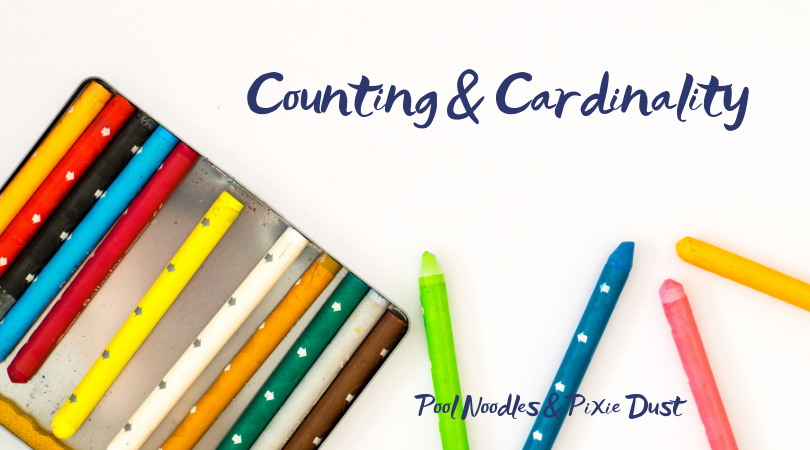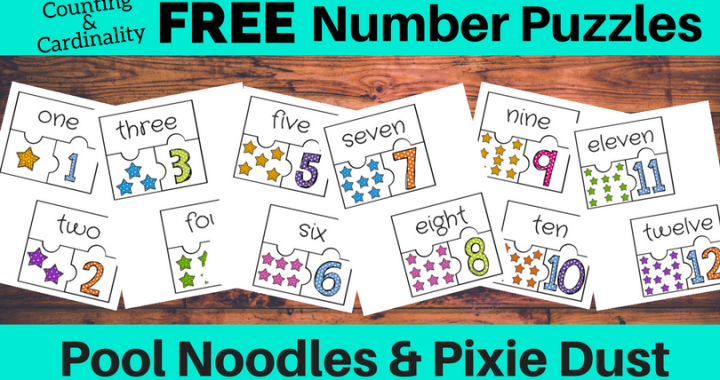We may earn money or products from the companies mentioned in this post.
Counting and Cardinality are two fundamental math skills in early childhood.
And, they are something you and I use every day. From balancing the checkbook (well let’s face it I don’t do that very often;) to grabbing the right amount of silverware for the dinner table every night.
Sometime during preschool or kindergarten children stop just repeating number sequences from memory. They gain a deeper understanding of math and move from counting to cardinality.
The more we work with our preschoolers and kinders on these concepts in concrete ways the more prepared for elementary math they will be. Digging into what is actually going on when a child is learning and mastering these skills is so helpful for us as parents and teachers when our children are developing them. So, let’s get started.

What is Counting?
Counting is being able to express how many things are in a group. For example, being able to count seven crayons laying on the table. But, there is more going on than memorization. Children begin to understand that when counting we aren’t always talking about what’s bigger. To master the skill of counting our children have to learn that one whale is not a bigger quantity of items than 3 ants. Even though that one whale is bigger in size, and almost every other way from those 3 ants!
Counting Skills:
Counting in sequential order
- They can count, using number words, in the correct sequence. For example, “one, two, three, four, five, six, seven.” That means they must learn each number word and what number symbol it represents, 1,2,3,4,5,6,7 and so on. Just as in phonics they have to learn that s says “ssss” in math they have to learn that “7” represents a specific and set quantity. And, these are abstract concepts. And, why kids need a lot of concrete practice to master them.
One-to-one Correspondence
- Understanding that one number word represents one, and only one, object while counting.
What is Cardinality?
Cardinality is when your child is able to understand that the last number in a sequence of objects they are counting, is the number of objects in the entire group. For example, if they count the seven crayons sitting on the table they understand that when they get to seven they have finished counting all the crayons. And, that that group of crayons represents the quantity seven.

Conservation of number
In the above scenario, you will know your child understands this concept when you can ask how many crayons are in the group on the table and they are able to answer seven no matter how they are arranged. So, for example, you have the seven crayons sitting side by side in a line and then you pick them up and drop them in a pile and your child still understands that there are 7 crayons in that group.
Subitizing is also an important skill in gaining a full understanding of cardinality. Subitizing is being able to instantly recognize how many objects are in a group. For example, your child looks down at the crayons on the table and knows there are seven without having to do other math to figure it out.
Practicing Counting and Cardinality Skills
Give your child lots of concrete practice counting objects. Use counters, cereal, or those crayons we’ve been talking about throughout this post.
One simple way I have done this with my children is in many, many readings of Goodnight Moon by Margaret Wise Brown.
For instance, on the page with the, “three little bears, sitting on chairs” I simply point to the bears one at a time and say, “one, two, three bears sitting on chairs.”
And, on the page with the, “two little kittens” I say, “one, two kittens” as I point.
The book is short, so it doesn’t take much more time for me to count the objects on the pages. Also, when my children began to “read” the story with me it was natural for them to “count” the bears and kittens as well. And, sure they were just repeating at first, but eventually, they understand the math skills involved.
Fun & Games
Games and fun toys are another great way to easily add the practice of these skills to your day. Here are a few we use.
Abacus
An abacus is great for concrete counting practice. My daughter and I just made a DIY Abacus that we’re having so much fun with.
Dominoes
Dominoes are one of my favorite toys/games for kids. I love that they’re like number blocks. My kids build with them, match them, carry them around. We use the Double 12 Color Dot Dominoes. They’re visually better to look at. But, it also helps in the very beginning stages of learning to count because kids can use the colors to help them match the tiles.
Dice
Dice are involved in lots of board games for children, so you don’t have to “add” them in anywhere. But, they are such a great tool that I didn’t want to skip over them. Just simply letting your children toss dice and either say or record how many dots are on each one is a great way to practice counting and cardinality concepts. Add some fun colored dice to your math time.
UNO
UNO is great for number recognition. When we play we have our daughter say the number of the card she lays down to reinforce the numbers. When she was younger it was a good way to help her learn her colors.
War
My daughter has been playing this game a lot lately. To play you divide a deck of playing cards up evenly between all players. Everybody turns over one card at a time. The player with the highest card wins and gets to keep their card and the other players turned card. If two of the same card comes out then the players “go to war”. Each person lays out three cards face down. And, a fourth face up. The highest card wins all the cards in the war. If it’s a tie you repeat the last step. Continue playing until one player has all the cards.
Other good card games for kids are Go Fish and Crazy 8’s. A plain deck of cards is great for a game of memory or just matching as well. My daughter has been starting to play Rummy with us. And, though she still struggles with the rules it is great for learning number sequences, quantity, and matching numbers.
